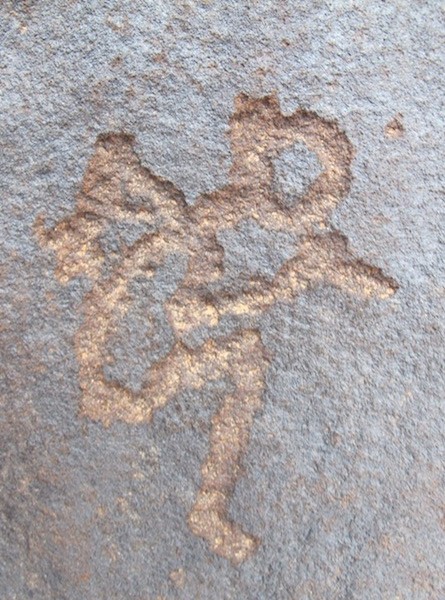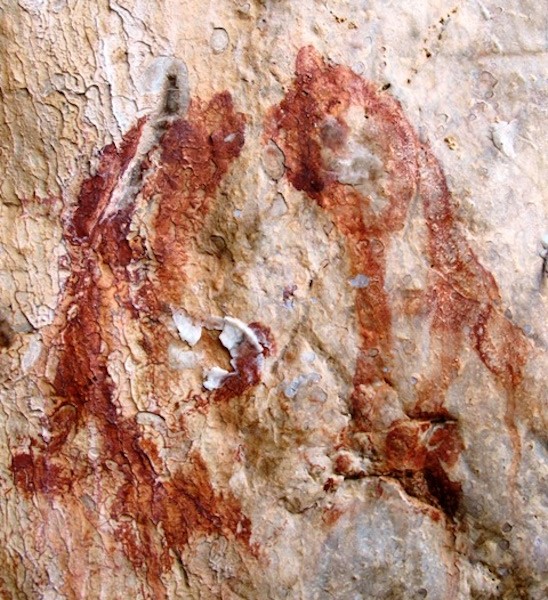
December 2012
John Vincent Bellezza
Welcome to another Flight of the Khyung to the land of Tibetan archaeology and history! This month’s four main features revolve around the ancient rock art of Upper Tibet, introducing important images never before published. So let us take off!
Mysterious and alluring: metal and stone parallels

Fig. 1. On this rock panel is a variety of figures that according to their style, manner of production and physical appearance seem to have been made in the same timeframe, western Tibet. These petroglyphs can provisionally be dated to the Iron Age (600–100 BCE) or perhaps somewhat earlier.
On the upper right hand side of the panel is a stylized depiction of a chariot, one of many found at this particular rock art site. These chariots document the introduction of a momentous ideological and technological innovation in Upper Tibet (for more on these chariots, see the August 2010 newsletter). Wild yaks are found on the upper left side of the panel and in the middle right. Another animal and an anthropomorphic figure (depicted horizontally) occupy the central portion of the image. Two spoked wheels are also visible in the middle tier of the panel. These wheels may possibly be symbolic of the sun and chariots, the association between these two things traceable to the Rig Veda of India and other late Bronze Age cultural traditions.

Fig. 2. A close-up view of the largest subject at the bottom of the same rock panel.
In the middle of the bottom portion of the panel is a square enclosing a motif resembling the ‘crossed thunderbolt’ (rdo-rje rgya-gram), the symbol par excellence of Vajrayana Buddhism. However, given its assigned age it cannot have anything to do with the tantric tradition of Buddhism, which arose no earlier than the 6th century CE. In my books Calling Down the Gods (Brill: 2005) and Zhang Zhung (OAW: 2008), I touch upon a dorje-like object of the Bonpo, which is reputedly of very ancient origins: the trapue (pra-phud). The actual historical identity and early appearance of the trapue, however, are not very clear. In my writings I suggest that it may possibly be represented in certain artifacts. I will apply this same hypothesis to the rock art motif under consideration, hastening to add that positive confirmation may still be a long way off.

Fig. 3. A similarly designed object of the Tibetan amulet group known as thokcha (thog-lcags), 2.5 cm in width. Private collection, photograph by author.

Fig. 4. The reverse side of the same copper alloy object.
The curiosity value of the cruciform motif in the rock art of western Tibet is enhanced by the existence of this ancient object cast from a copper alloy. This artifact resembles a crossed thunderbolt, a fairly unusual and highly prized subject in antique Tibetan amulets. Nevertheless, the design of the cruciform is somewhat unconventional, as it lacks clearly defined prongs. Also, as a similar motif has been identified in the prehistoric rock art record, an alternative identity must be considered. Trapue or dorje, be that as it may, this object was cast from a lustrous white verdigris-resistant, high quality copper alloy suggesting an early historic period (650–1000 CE) attribution (as does its overall appearance). An even earlier date can possibly be entertained but this remains mere speculation. Relatively little is known about the origins and development of metallurgy in Tibet, for relatively few early artifacts have been conclusively dated or their provenance fixed. Moreover, no ancient metal making workshops have yet been unearthed.
More strange figures or symbols

Fig. 5. Six geometric figures accompanied by a yak and another animal, western Changthang.
These intriguing figures remain unidentified. It is not known if they represent actual physical objects or if they are signs or symbols of some kind. The four large central subjects have campanulate forms with head-like tops. They are each divided into a multiple of squares. The elements of the two smaller specimens flanking them are not as well developed and they may not even be of the same portrayal. A yak and another animal to its right are found at the bottom of the boulder. All carvings on this rock appear to have been made in the same period, suggested by their uniform execution traits and wear qualities. This rock art appears to date to either the Iron Age or protohistoric period (100 BCE to 650 CE). There is almost no evidence of later era art or inscriptions at this particular rock art site.
The geometric motifs under consideration bear a slight resemblance to the so-called mascoids of northwestern Tibet (for more on these mascoids, see December 2011 newsletter). Some of these mascoids are also depicted in close association with wild yaks. There are however significant differences between the respective subjects. Thus even if these carvings are mascoids, they represent a distinctive regional tradition and one of less complexity and artistic merit. Other possible identities for this enigmatic rock art can also be envisaged, from renderings of different family encampments to esoteric ritual instruments, but I am at a loss to suggest which ones are more plausible.
Making music the old way

Fig. 6. An anthropomorphic figure holding an object to its mouth, western Tibet.
This remarkable petroglyph depicts a graceful figure holding an elongated object to its mouth. The manner of grasping the object and its relative placement give the impression that it is a flute. The flexed figure appears to be squatting or perhaps even flying, an acrobatic aspect reinforced by the wing-like extensions on the back. The carving is located at a place where prehistoric rock art abounds. On the basis of the general character of the site’s contents, carving technique and artistic style, this composition can provisionally be dated to the late Bronze Age (1200–600 BCE) or Iron Age. Provided the chronological attribution and subject identification suggested here are valid, this is the oldest known portrayal of a musician in Tibet. Flutes are of course one of the most ancient musical instruments in the world, and they have been known in Tibet for many centuries. The presence of a flute in prehistoric rock art would corroborate its ancient associations in the Tibetan literary record. According to an Old Tibetan language origin myth (written prior to 1000 CE) studied in my forthcoming book, Death and Beyond in Ancient Tibet, the flute is of a primal origin, a heavenly instrument associated with the afterlife or ancestral realm.
Ancient piscine rock art
While not very common, in addition to many other types of animals, fish are also found in the rock art of Upper Tibet. These fish can be divided along the lines of the two great religious traditions of Tibet: archaic and Lamaist. In this final feature of the newsletter we shall view some of this rock art.

Fig. 7. A pair of fish painted in a cave, one of the eight auspicious symbols of Yungdrung Bon and Buddhism, probably vestigial period 1000–1300 CE), eastern Changthang.
This pair of red ochre fish is found among other standard forms of the eight auspicious symbols (bkra-shis rtags-brgyad). However, in this particular instance the ensemble of painted symbols is incomplete. Although rather crudely drawn, the depiction reproduces the conventional features of the pair of ‘golden fish’. The mouths, fins and tails are clearly recognizable in this pictograph. The golden fish symbolize the dharmic teachings and instruments that carry one across the sea of pain and suffering, thus they possess the connotation of fearlessness and happiness. The eight auspicious symbols originated in India with Buddhism and other religious traditions. Golden fish are also an ancient royal symbol of the Subcontinent, and as burial objects were discovered in high status tombs of the Scythians.

Fig. 8. A red ochre fish probably representing the scaleless carp (Gymnocypris przewalskii) of the great lakes of Upper Tibet, early historic period or vestigial period, eastern Changthang.*
The scaleless carp is native to the large brackish lake found in view of this pictograph, further suggesting that this is indeed its identity. These slow growing fish live in the deep, cold waters and reach more than 1 m in length. The herders of the region even speak of giant carp 2 m or more in length, but I cannot personally confirm this. There are also legends of colossal golden fish dwelling in the big lakes of Upper Tibet. This fish pictograph is one in a group of auspicious symbols that includes a five-pointed star, conch (dung), endless knot (dpal-be’u), and victory banner (rgyal-mtshan). The unconventional composition and style of these symbols and the presence of the eight-syllable Yundgrung Bon mantra (Om ma tri mu ye sa las ’du) in close proximity suggest that this series of auspicious symbols was drawn by non-Buddhists.
* This same pictograph is illustrated in “Gods, Hunting and Society: Animals in the Ancient Cave Paintings of Celestial Lake in Northern Tibet”, East and West [Rome], vol. 52, 2002, p. 393 (fig. 53). For access to this paper, see articles section of website.
Also see “Metal and Stone Vestiges: Religion, Magic and Protection in the Art of Ancient Tibet” in Asian Art Online Journal, fig. 7a, http://www.asianart.com/articles/vestiges/index.html

Fig. 9. A rock carving of what appears to be a scaleless lake carp, probably protohistoric period, northwestern Tibet.
This petroglyph also exhibits anatomical features associated with carp found in the lakes of the Tibetan Plateau. Located on the opposite end of the vast Upper Tibetan highland from the specimen in Fig. 8, it shares many of the same basic traits such as the elongated body, rounded head, two sets of fins and narrow tail. The carved fish is one of a number of animals that appear to form a unified composition at a location with a preponderance of rock art predating the historic era. The animals of this composition may have had cultural, social or economic significance for their makers and users, the specifics of which remain theoretical.

Fig. 10. Two carved fish, Iron Age or protohistoric period, northwestern Tibet.
An examination of their production traits suggests that these two fish (carp?) may have been carved at different times (note the differences in re-patination, texture and style). They exist as separate subjects without direct thematic links to other rock art in close proximity. Fish play an important role in ancient religious traditions as manifestations and emblems of water spirits known as lu (klu). According to literary and oral materials, the lu most commonly come in three varieties of fish: gold, turquoise and conch white. Other animals popularly associated with the lu include frogs, turtles, scorpions and snakes. The lu possess fertility and wealth functions and are regularly propitiated by women. Whether any of this still existing cultural lore can be applied to understanding the fish petroglyphs under examination is a moot point. Nevertheless, as the cult of the water spirits has every indication of being extremely old and persistent, certain of its elements may well be embodied in this rock art, cultural continuity being a pervasive theme in the Tibetan world.